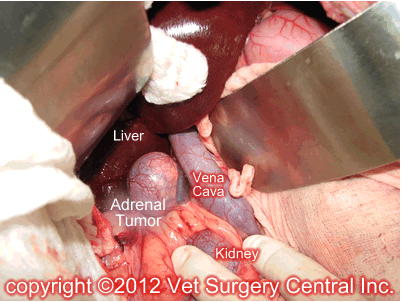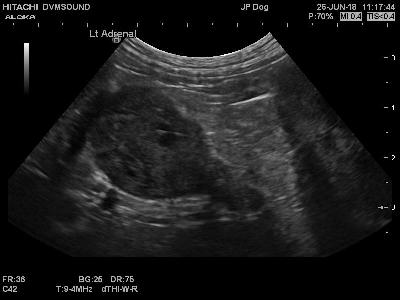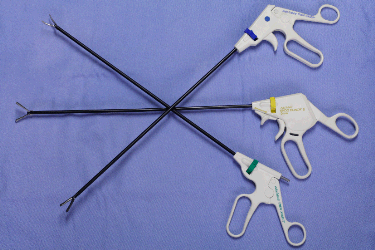|
ADRENAL TREATMENT


Surgical view of an adrenal tumor within the "Bermuda Triangle" of the abdomen.
(Photocredit: Vet Surgery Central Inc. Used with permission)
We will begin this section with the assumption that the presence of an adrenal tumor has already been confirmed with either blood testing, special imaging or both. There are two questions that must be answered next:
- IS THE TUMOR BENIGN OR MALIGNANT?
- SHOULD YOU CHOOSE SURGICAL TREATMENT OR MEDICAL MANAGEMENT?
BENIGN VS. MALIGNANT
While only approximately 15% of canine Cushing’s syndrome patients have adrenal tumors, half of these patients will have benign tumor and half will have malignant tumors. The choice of therapy may well depend on which is present.
If imaging has not yet been performed, this is the time to do so. Chest radiographs will be important as malignant adrenal tumors tend to spread to the chest. If such spread is seen, the tumor can be assumed to be malignant. Absence of such findings, however, does not mean the tumor is benign. Ultrasound of the abdomen, if this has not already been done, (or even CT scanning, MRI imaging, or nuclear medicine scanning) will be needed to determine the size of the tumor, and to check for invasion of local abdominal tissues (especially liver).
|
Between evaluation of the chest and the abdomen, it may be possible to non-invasively determine if the tumor is malignant. It should be noted that the absence of tumor spread does not mean that the tumor is benign. If there is obvious spread to other organs, medical management is the only meaningful hope for the patient. It may be necessary to consult with an oncologist for the most current medication plan.
WHAT IF IMAGING FAILS TO CONFIRM THAT THE TUMOR IS MALIGNANT?
As mentioned, it is not possible to say that the tumor is benign simply because tumor spread has not been detected. Still, no evidence of spread is about as close to determining that the tumor is benign as we can get without actually obtaining tissue samples. If the adrenal tumor is benign, there is an excellent chance for complete recovery if the tumor is surgically removed. The smaller the tumor, the easier the surgery, though the surgery involves delicate tissue in a difficult area.
|

Ultrasonic imaging of an Adrenal tumor
in a dog with Cushing's Disease.
(Photocredit: Image by Marvistavet.com and DVMSound)
|
WHAT IF IMAGING INDICATES THAT THE TUMOR IS MALIGNANT?
If there is obvious tumor spread, surgery may be too risky. The decision to proceed with medical therapy will depend on patient debilitation and the degree of tumor spread versus the severity of the clinical signs of Cushing’s disease. Palliation of the clinical signs may be achieved with just partial removal of the tumor. Medical management with trilostane or with high doses of lysodren would be fair alternatives.
WHAT YOU SHOULD KNOW ABOUT SURGERY
- Removal of the adrenal gland is a difficult surgery and is probably best left to board certified surgeons who perform this surgery with some regularity. (The adrenal gland is located between the aorta, which is the largest artery of the body, the renal artery and vein, which are the sole blood supply to the kidney, and the phrenicoabdominal artery. This especially vascular area is half-jokingly referred to by surgeons as the “Bermuda triangle.” Surgery here is not for the inexperienced.) Removal of an adrenal tumor is generally considered to be one of the most difficult surgeries in all of veterinary practice.
- Risk of bleeding is higher for larger tumors especially if they are malignant and have invaded local structures. It is quite possible that the full extent of such invasion will not be apparent prior to the time of surgery.
- Animals with Cushings syndrome have poor healing ability and tend to have high blood pressure. Several months of medical therapy (i.e. lysodren or trilostane) prior to surgery may be a good means to strengthen the patient, especially if the tumor is believed to be benign. If the tumor is believed to be malignant, there may not be time for such stabilization.
- The dog’s natural cortisone mechanisms will have been suppressed by the tumor's presence. This means the patient will not be able to produce adrenal steroids on his or her own for a while and they will need to be given as medications. Several months of prednisone will likely be required at home. Some patients require florinef as an additional supplement. ACTH stimulation test are used to monitor the need for medication.
- Adrenal tissue is notoriously difficult for pathologists to grade as benign or malignant. It is possible that as tumor initially graded as benign will turn out later to be malignant.
- A statistical survey of 63 dogs under-going sugery for their adrenal tumors:
|
-- 6% (4) had inoperable tumors and were euthanized on the surgery table.
-- 29% (18) died either in surgery or shortly thereafter due to complications.
|
- Average life span for dogs undergoing surgery is 36 months (this includes averaging in those who died shortly after surgery)
|
 Laparoscopic surgical equipment Laparoscopic surgical equipment
(Photocredit: Ignis via Wikimedia Commons)
|
- The most common serious complication is thromboembolism (abnormal blood clots) which typically happens in the first 24 hours after surgery. This risk is tremendously reduced if the surgery can be performed by laparoscopy. Incisions are smaller, organ manipulation and bleeding is less and recovery is faster. Laparoscopy utilizes several small holes in the belly wall through which instruments including a small video camera can be inserted. Surgery takes place inside the belly and is viewed on a video screen or through a lens.
|
MEDICAL THERAPY FOR THE ADRENAL TUMOR
As can be seen from the above discussion, adrenalectomy is a high risk surgery. It may not be a good choice for an elderly debilitated patient, especially if the tumor is large or has evidence of spread. Further, a 24 hour specialty center is needed for this sophisticated procedure and these centers may not be accessible and there is a great deal of expense involved in a surgical adventure of this magnitude. For these reasons, medical management may be selected as an alternative.
Lysodren is a drug of chemotherapy which is able to erode the cortisol-producing layers of the adrenal gland. This ability has made lysodren, for decades the traditional medication for the treatment of pituitary Cushing’s disease, helpful in treating adrenal tumors as well. The higher doses needed to control adrenal tumors tend to produce more lysodren reactions than are seen in the treatment of pituitary tumors. The average survival time for this type of therapy is 16 months.
For a review of the basics of lysodren therapy click here.
Trilostane can also be used for functioning adrenal tumors though it will not actually erode adrenal tissue (which could potentially erode the tumor). Trilostane acts by inactivating excess steroid hormones and thereby managing the symptoms of Cushing's disease. One would think that this would not be effective since it does not directly affect the tumor but at least one study showed a comparable survival time to that of patients on lysodren. As with lysodren, a special protocol is needed that is different from the protocols using the same drugs in the treatment of pituitary-dependent Cushing's disease.
For a review of the basics of trilostane therapy click here.
|
|
SOMETHING DIFFERENT: HYPOFRACTIONATED STEREOTACTIC RADIOTHERAPY
A study presented in 2014 by a group of Italian researchers treated 12 dogs with adrenal tumors with this special type of radiotherapy and all 12 of them responded. After 12 months, 11 patients were not only still alive but their Cushing's syndromes were controlled as well (the 12th patient had died of unrelated causes). This type of therapy was considered to be far less risky than surgery and the researchers recommended further investigation. Stereotactic radiotherapy involves highly specialized equipment and is not readily available but might be worth travel depending on where it might be located. An oncologist should be consulted for more information.
|
|
|

Page last updated: 9/23/2025
|